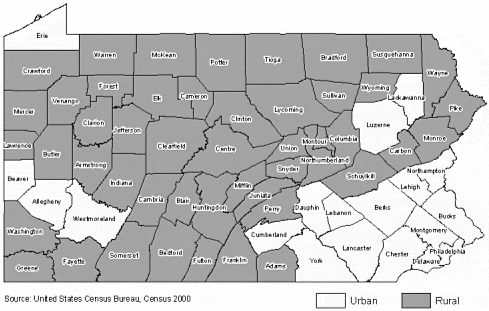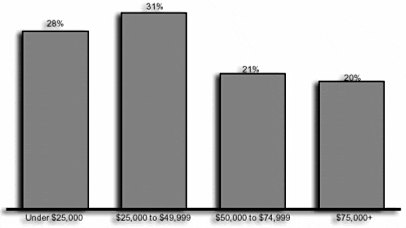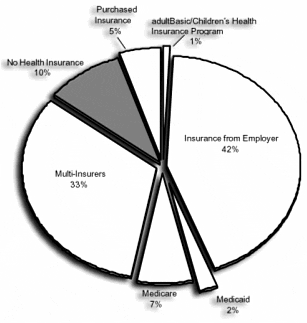Newsletters
- Home
- Publications
- Newsletter Archive
- Newsletter
September/October 2005
Inside This Issue:
- New Center Survey Provides Closer Look at Pennsylvania Rural Residents
- Chairman's Message
- Rural Works: Tamaqua Community Partnership Continues to Build on Decade of Revitalization Efforts
- Claysburg-Kimmel School District Receives Award for Education/Community Program
- Federal Expenditures in Rural Pennsylvania
- Did You Know . . .
- Just the Facts: Home-Schooled Rural Children
New Center Survey Provides Closer Look at Pennsylvania Rural Residents
Data geeks beware: others may be joining your circle, thanks to the availability of new information compiled by the Center for Rural Pennsylvania. The recently completed Rural Pennsylvania Current Population Survey (RuralPA-CPS) provides baseline data on the state’s rural households and individuals and will be updated every year. This dynamic database will enable data users to get behind the numbers to better understand the conditions faced by specific populations, such as single parents, the rural elderly, and the uninsured. Information from the database will be shared with the Pennsylvania General Assembly, as it considers Commonwealth policies, and with the public.
The annual RuralPA-CPS is modeled after the March supplement of the Census Bureau’s Current Population Survey (CPS). Unlike the federal survey, and the decennial census, the RuralPA-CPS focuses solely on Pennsylvania’s 3.4 million rural residents.
The RuralPA-CPS is a phone survey of rural households throughout Pennsylvania. It was conducted from January to March 2005 by Penn State Harrisburg’s Center for Survey Research.
In the years ahead, as the Center builds upon the data from this first RuralPA-CPS, it will be able to compare and track the data to identify special populations in rural areas and compare the data to the results of the federal CPS.
2005 RuralPA-CPS
The response rate for the 2005 RuralPA-CPS was 48 percent, or 2,014 households. Different questions had different response rates, however, depending on whether the question was about the entire household or individuals within the household. Response rates also differ based on how many respondents answered each question. Following are just some of the demographic data collected from the RuralPA-CPS.
Age
- In 2005, the average rural resident was 41 years old. About 22 percent of residents are under 18 years old and 16 percent are 65 years old and older.
- The average rural household has 2.5 persons. Households with children, however, have an average of about 4.0 persons.
- The average single mother is 41 years old and her two children are 11 and 13 years old.
- The number of rural Pennsylvanians under 30 years old is twice the number of those 65 years old and older.
Income
- Almost 12 percent of rural households are near or below the poverty level.
- Among the households in or near poverty, about 10 percent receive Temporary Assistance for Needy Families (TANF) benefits, and 50 percent receive Food Stamps.
- Thirty-five percent of rural households have no income from wages or salaries. The average age of these householders is 56 years old.
- The average upper-income household ($75,000 or more) spends $647 each month on rent or mortgage payments. Lower-income households (less than $25,000) spend an average of $198.
- Sixty-three percent of all respondents have household members who work for employers that offer some type of retirement plan.
Health Insurance
- Approximately one in 10 rural Pennsylvanians does not have health insurance.
- Twenty-seven percent of individuals without health insurance live in households with incomes greater than $50,000.
- Seventy-one percent of rural residents with health insurance through their employer must make premium contributions.
Education
- The average rural adult without a high school diploma is 59 years old. The average age of an adult with a bachelor’s degree or higher is 50.
- Adults with a bachelor’s degree or higher are 32 percent more likely to live in a household that has an income in excess of $60,000 than an adult with a high school diploma or equivalent.
- Twenty-four percent of both rural adult women and men have a postsecondary degree.
Employment
- The unemployment rate was 6.9 percent for rural adults age 18 to 64 years old who are in the labor force. The average unemployed person was a 39-year-old female with a high school diploma.
- Twenty-two percent of rural teenagers (15 to 17 years old) are employed part-time.
- Ten percent of rural senior citizens (age 65 and older) are employed; 54 percent are employed part-time and 46 percent are employed full-time.
- Among employed working age rural residents, 23 percent work part-time only.
- Forty-three percent of rural households with children have two or more wage earners.
More information available
For a copy of the RuralPA-CPS results, Rural by the Numbers, call the Center for Rural Pennsylvania at (717) 787-9555 or email info@ruralpa.org.
Pennsylvania Rural Counties

The RuralPA-CPS, conducted from January to March 2005, allows data users to get behind the numbers and better understand Pennsylvania's rural population.
Rural Household Incomes, 2005

Rural Households and Health Insurance, 2005

Chairman's Message
Change is constant. And the Center for Rural Pennsylvania is no exception to this rule. We are fortunate to have a board of directors that is well served by representatives of state government and the state’s universities. The Pennsylvania State System of Higher Education appointee is one of these valued volunteers.
Recently, I welcomed Dr. John Halstead of Mansfield University as a new board member. With this issue of Rural Perspectives, the Center for Rural Pennsylvania will be wishing Dr. Halstead success as he moves to our neighboring state to the north to take on the leadership of a university in New York. Filling his appointed position on the Center’s board is Dr. Keith Miller, president of Lock Haven University. I look forward to his future contributions to the decision-making activities of the board, and welcome his expertise and experience.
Did you ever wonder how many people call rural Pennsylvania home? The answer to that question is nearly 3.4 million Pennsylvania residents. That’s 28 percent of the state’s 12.3 million residents. While these statistics are impressive, the Center for Rural Pennsylvania decided to undertake a closer look at the folks who comprise our rural population.
The staff built on the demographic information compiled by the U.S. Census Bureau, and expanded its sample survey size to conduct the first annual Rural Pennsylvania Current Population Survey from January to March of this year. The RuralPA-CPS, as we’re calling it, was modeled after the Census Bureau’s Current Population Survey and will provide the Pennsylvania General Assembly and the public with more information about our rural residents, especially in terms of their age, income, education, health care, employment and much more. While we feature only some of the results of the RuralPA-CPS on Pages 1 and 3, we can share a copy of the complete results with you if you call or email the Center.
Many things have certainly changed in Tamaqua during the past decade. In 1994, citizens of the Tamaqua area created the Tamaqua 2004 Partnership, a 10-year initiative to help revitalize their area. Last year, the citizens of the area celebrated their work and recommitted themselves to continuing the project. Read more about the partnership’s accomplishments and its plans for the future in our Rural Works series on Page 4.
What the federal government invests in rural Pennsylvania is more than small change, according to the Census Bureau’s report on federal expenditures. In 2003, Pennsylvania’s rural counties received more than $23 billion, which amounts to $6,753 per person, an increase of 29 percent during the decade. You can read more about the Consolidated Federal Funds Report and compare urban versus rural receipts by turning to Page 6.
Finally, we always look for reasons to celebrate and share good news. On Page 5, be sure to read about the Rural Works submission that was featured in our January/February issue of Rural Perspectives. The Claysburg-Kimmel School District, located in Blair and Bedford counties, received the first annual Building Community Through Rural Education Award for its Child PREP Program. The program actively involves parents in their child’s early education. Congratulations to the district and best wishes for continued success.
Representative Sheila Miller
Rural Works: Tamaqua Community Partnership Continues to Build on Decade of Revitalization Efforts
This article is part of a series that demonstrates how communities are tackling issues at the grassroots level in rural Pennsylvania. Thanks to those who shared the details of their projects with us. Now, we can share them with you so that we can all learn how rural works in Pennsylvania.
Innovation, regionalism and a lot of hard work make a winning combination. Just ask residents of the Tamaqua area, where all of these elements have been working for more than a decade. Residents of Tamaqua, a small town tucked away in the northeastern coal country of Schuylkill County, had witnessed their town age and slide away from the downtown prominence of earlier generations and decided to reinvigorate and revitalize their area and start it on the path of renewal.
A partnership is formed
In 1994, a local businessman approached Representative David Argall to discuss the need to revitalize the area. After a few meetings, area citizens, businesses, and school, local and state officials developed a 10-year plan to help revitalize the area and officially formed the Tamaqua 2004 Partnership. “We were optimistic and realistic,” said Micah Gursky, the partnership’s initial director. “We knew we would need a long-range plan to accomplish our goals and the partnership’s name would help us to keep our eye on our goals and our timeline.”
The focus of the partnership centered on four specific areas: economic development, historic preservation and tourism, recreation, and downtown revitalization. In addition to businesses and citizens, the partnership was made up of representatives from the Tamaqua Area School District and five municipalities in the Tamaqua area: Rush Township, Schuylkill Township, Walker Township, West Penn Township, and Tamaqua Borough.
Since 1994, the partnership has successfully established a Main Street Program, resulting in structural improvements to the downtown area. It also has established an Inter-Municipal Recreation Committee that has driven vast improvements to local parks.
Tamaqua is also witnessing the benefits of the state’s Keystone Opportunity Zones, which provide state and local tax abatement to businesses and residents in the designated “zones.” As of 1999, 13 businesses have been established because of the program. Among these and other accomplishments, the partnership designed and purchased downtown banners and designed historic district markers for the area to welcome visitors and brighten the streets of Tamaqua.
Keeping the partnership on track
While the year 2004 has come and gone, Gursky said the partnership has not stopped its efforts to improve the Tamaqua area. It has, however, given itself a new name: the Tamaqua Area Community Partnership. It also decided to reevaluate its goals and objectives for the coming years. In the process of creating a new vision and mission statement, the partnership decided to keep many of its original goals, hoping to fulfill more objectives within the four central areas, with an added emphasis on tourism.
According to Gursky, now that downtown Tamaqua has been given such a great makeover, it is time for it to capitalize on the beauty of the downtown and the surrounding area. To do so, the partnership will continue to take advantage of statewide programs, such at the state’s Main Street and Elm Street Programs, which offer assistance to revitalize the downtown and existing neighborhoods. And, it will continue to support and promote heritage tourism to make the entire region a tourist destination.
Gursky said: “By continuing to build on its accomplishments, the partnership hopes to achieve its goal of helping residents of the entire Tamaqua area enjoy a better quality of life.”
The Rural Works Breakdown: Tamaqua Area Community Partnership
Goals/Mission: To improve the quality of life in the Tamaqua area with a focus on four areas: economic development, historic preservation and tourism, recreation, and downtown revitalization.
Funding and In-Kind Support: Began with in-kind contributions from local businesses and community members, followed by Rural Initiative support from the Center for Rural Pennsylvania. Now, the partnership receives a wide variety of funding from the Main Street Program to its six-municipality recreation commission.
Manpower: Elected officials, hundreds of volunteers, a Main Street manager, and a Recreation Commission manager.
Measurable Outcomes: Establishment of the Main Street Program, which has led to great physical improvements to the downtown area. Establishment of the Inter-Municipal Recreation Commission, which has improved the parks in the area.
Challenges: Having enough funds and volunteers to complete projects.
Advice for Replication: Be patient, lay out a vision, and dedicate yourself to the necessary workload that comes along with your goals.
Contact Information: Linda Yulanavage, Main Street manager, or Pat Stefanek, chairperson of the Tamaqua Area Community Partnership at (570) 668-6899 or email downtowntamaqua@verizon.net.

A crowd gathers at the dedication of the restored 1874 Tamaqua Passenger Station. The station now is home to a regional visitor’s center, restaurant, gift shop and candy shop. (Photo courtesy of the Tamaqua Area Community Partnership.)
Claysburg-Kimmel School District Receives Award for Education/Community Program
The Claysburg-Kimmel School District received the first annual Building Community Through Rural Education Award, sponsored by Penn State University’s Center on Rural Education and Communities and the Pennsylvania Association for Rural and Small Schools.
The annual award is presented to recognize a rural school or district that has distinguished itself through innovative practices contributing to the educational experiences for the students it serves, while reaching out to the broader community in which it is located.
The Claysburg-Kimmel School District, located in Blair and Bedford counties, received the award in April 2005 for its efforts to improve education and build community through its Child PREP Preschool Program, which works directly with parents of preschool-aged children to provide support, training, information and access to thousands of books and age-appropriate learning materials. The Child PREP Program was featured in the January/February 2005 issue of Rural Perspectives as part of the Rural Works series.
Nine other districts received honorable mentions, including:
DuBois Area School District for creating a School Business/Industry Network in which graduating seniors are linked with area business professionals who provide mentorship, career guidance and evaluation of student portfolios;
Forest City Regional School District for building a strong community service program into the broader expectations connected to high school graduation;
Glendale School District for introducing a broadband and information technology initiative that has transformed this resource-limited rural district into a state-of-the-art showcase as a “high tech” school, and for working to create a rural broadband consortium ultimately encompassing more than 60 school districts;
Northern Lebanon School District for creating a partnership with local employers and government to share the costs of community services and create a GIS-based community database used for short term and long-range planning;
Otto-Eldred School District for responding to the need for more space for its preschool students by forming an agreement with the regional Vocational Technology School, and enlisting VoTech students in the effort to build the future preschool building under the supervision of their instructors;
Port Matilda Elementary School (Bald Eagle School District) for partnering with the Retired and Senior Volunteer Program (RSVP) to create a pen pal program linking the school’s elementary students with the area’s senior citizens;
South Side Area School District for developing a service-learning center integrating community service into the school curriculum;
Warren County School District for the organization of a Warren Forest Childcare/School Readiness Coalition in which Warren County School District works with area child care centers to provide materials and support to ensure that child care centers are addressing school readiness and early childhood learning; and
Windber Area School District for its partnership with the Windber Medical Center and the Windber Research Institute to create a job shadowing program and to conduct an eight-week research project on obesity and cancer trends that led to a school wellness program and student participation in the presentation of the research results at the Biotech Showcase.
For more information about the awards program, contact Kai Schafft, the Center on Rural Education and Communities, Penn State University, Department of Education Policy Studies, 204B Rackley Building, University Park, PA 16802, Phone: (814) 863-2031 or email: kas45@psu.edu.
Federal Expenditures in Rural Pennsylvania
Each year, the Census Bureau publishes data on federal expenditures to each state, county, and municipality in the nation in the Consolidated Federal Funds Report. In 2003, the federal government spent more than $23 billion in Pennsylvania’s rural counties, which amounts to $6,753 per capita.
Adjusted for inflation, federal expenditures to rural Pennsylvania increased by 29 percent between 1993 and 2003. Accounting for population growth, the per capita increase was still 26 percent. However, expenditures to urban Pennsylvania are and have consistently been higher in raw numbers as well as in per capita rates. In 2003, urban Pennsylvania received nearly $72 billion or $8,030 per capita.
In 2003, the greatest portion of federal money into rural Pennsylvania, 39 percent, came in the form of retirement and disability payments, much of which are social security payments. The next largest portion, 22 percent, was other direct payments, such as Medicare, unemployment compensation, housing assistance, and food stamps. Grants, which include highway money, Temporary Assistance for Needy Families (TANF), Medicaid, and other grants, accounted for 17 percent. Loans and insurance were 12 percent while procurement and salaries and wages each made up 5 percent of total federal expenditures.
The breakdown was a bit different in 1993 when 45 percent went to retirement and disability, 7 percent went to salaries and wages, and slightly less went to each of the other categories.
Federal expenditures to rural Pennsylvania, adjusted for inflation, increased in nearly every category over those 10 years. However, real salaries and wages decreased by 11 percent. This may be related to a decrease in the number of federal employees. Meanwhile, funds for loans and insurance, the fastest growing category, increased by 74 percent. Retirement and disability was the slowest growing with a 15 percent increase. The remaining funding categories each increased by more than 30 but less than 50 percent. Urban changes showed similar rates but grants and other direct payments increased much more slowly than in rural areas.
Regionally, there are some interesting variations in the 2003 breakdown that seem to differ most in opposite corners of the state. In the southeast, the state’s most urban region, just 29 percent of federal expenditures were for retirement and disability payments, while this figure was 43 percent in the mostly rural northwest. These same regions show the largest difference in procurement and in salaries and wages as well. Procurement was 11 percent in the southeast and 2 percent in the northwest while salaries and wages were 9 and 4 percent, respectively. Twenty percent of federal spending in the northeast was loans and insurance while this figure was just 7 percent in the southwest. Grants made up just 12 percent of federal funds in the northeast compared to 25 percent in south central Pennsylvania.
Did You Know . . .
| 8,396,814 | Number of licensed drivers in Pennsylvania in 2004. A |
| 10,567,540 | Number of registered in-state vehicles in 2004. A |
| 120,423 | Number of highway miles in Pennsylvania in 2003. B |
| 8,954 | Combined road miles in all Pennsylvania boroughs, which is the equivalent of about one trip around the earth’s equator. C |
| 13,659 | Number of traffic lights in Pennsylvania in 2004. B |
| 1925 | Year Pennsylvania issued its first state highway map to aid the motoring public. D |
| 137,051 | Number of vehicle crashes in 2004. E |
| 22,176 | Number of bridges in Pennsylvania in 2003. F |
| 42.2 | 42.2 Percent of Pennsylvania bridges in 2003 identified as structurally deficient or functionally obsolete. F |
| 17 mpg | Average fuel consumption of all vehicles in the U.S. in 2002; in 1981, the average was 13.6 miles per gallon. F |
| 14 | Number of Welcome Centers operated by the Pennsylvania Department of Transportation and the Pennsylvania Turnpike Commission. G |
| 120 | Number of trains Amtrak operated daily in Pennsylvania in 2003. H |
| 4.6 million | Amtrak’s ridership in Pennsylvania in 2003. H |
| 16 mph | Average speed for rural and small city buses in 2003. H |
Sources: A, Pennsylvania Department of Transportation (PennDOT), Driver and Vehicle Services; B, PennDOT, Bureau of Planning and Research; C, PennDOT, Bureau of Municipal Services; D, PennDOT; E, PennDOT, Bureau of Highway Safety and Traffic Engineering; F, U.S. Federal Highway Administration; G, PennDOT Welcome Centers; H, PennDOT, Bureau of Public Transportation.
Just the Facts: Home-Schooled Rural Children
Throughout rural Pennsylvania, an increasing number of parents are seeking educational alternatives for their children. One alternative is home schooling. According to data from the Pennsylvania Department of Education, between 1995 and 2004, the number of rural students being home schooled increased 75 percent.
Despite this dramatic increase, rural students being home schooled in 2004 only made up 2 percent of total student enrollment. In urban areas, home schoolers made up 1 percent of total student enrollment.
While the data does not offer information on why parents choose to home school their children, it does illustrate some interesting patterns between rural communities with high and low percentages of home schoolers. In 2004, 54 communities had a high percentage of home schoolers, or two times more than the statewide average of 1.3 percent of total student enrollment. There were 20 rural communities that had a low percentage of home schoolers or two times less than the statewide average. Rural communities with a high percentage of home schoolers are generally located in the south central region and along Pennsylvania’s northern tier. Communities with low percentages of home schoolers are largely clustered in western Pennsylvania.
Statistically, places with a high percentage of home schoolers are more affluent than places with a low percentage of home schoolers. According to U.S. Census Bureau data, in 2000, high-percentage communities had an average household income of $48,973, or nearly $9,200 more than low-percentage communities. In addition, housing values in high-percentage communities are nearly $39,000 more than they are in low-percentage communities.
Along with an income gap, there is also an educational gap between the two types of communities. Census data indicate that in high percentage communities more than 14 percent of adults have a college degree compared to only 10 percent in communities with a low percentage of home schoolers.
Aside from wealth, there is very little relationship between the percentage of home-schooled students and other school district indicators. The student-teacher ratio, for example, in both types of school districts was below the statewide ratio of 16.3 students per teacher. Similarly, there was no statistical difference in average test scores, incidents of school violence, and dropout rates between the two types of districts.
